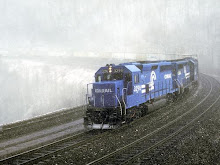This being my idea, I did just that.
I've decided to base the standards off of the BANTRAK OneTRAK standards, published here:
Use the BANTRAK Onetrak standard for track and electrical.
No grades built into the modules. - They can be added easily by shimming/adjusting the leveling bolts, but can't be "removed" if built into the module. This will prevent many potential operating headaches, while still giving us the ability to go for broke when we have the chance. This is speaking from lots of experience. Building the grades in will be NOTHING but trouble. I can assure this.
Track spacing - Use the BANTRAK spec for the two "far" spaced tracks, and place the close track at a 1" spacing. This won't be perfectly prototypical, but will provide the correct effect AND will allow us interoperability.
Joiner tracks - Use the BANTRAK spec. Removable joiner tracks, while a bit of a pain, are an essential part. The modutrak guys have gotten lucky, but I don't trust luck. These are a good way to make up for unevenness, incorrect setbacks, electrical isolation, etc... as I said, this is years of experience speaking here.
No grades built into the modules. - They can be added easily by shimming/adjusting the leveling bolts, but can't be "removed" if built into the module. This will prevent many potential operating headaches, while still giving us the ability to go for broke when we have the chance. This is speaking from lots of experience. Building the grades in will be NOTHING but trouble. I can assure this.
Track spacing - Use the BANTRAK spec for the two "far" spaced tracks, and place the close track at a 1" spacing. This won't be perfectly prototypical, but will provide the correct effect AND will allow us interoperability.
Joiner tracks - Use the BANTRAK spec. Removable joiner tracks, while a bit of a pain, are an essential part. The modutrak guys have gotten lucky, but I don't trust luck. These are a good way to make up for unevenness, incorrect setbacks, electrical isolation, etc... as I said, this is years of experience speaking here.




